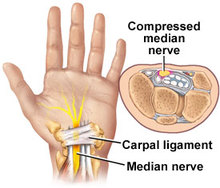Carpal Tunnel Syndrome

Carpal tunnel syndrome is a type of neuropathy that occurs when the median nerve becomes entrapped or compressed in the carpal tunnel of the wrist. The carpal tunnel receives its name from the eight carpal bones located in the wrist, called carpals, which form a “tunnel” through which the nerve passes and extends into the hand. The most common causes of CTS are repetitive stress injuries such as typing and computer use, as well as morbid obesity, stress and pregnancy. Women are more likely than men to develop CTS and those with hypothyroidism, Lyme disease and menopause are more at risk.
Symptoms of carpal tunnel include pain, numbness and tingling sensations of the thumb, index and middle fingers.
Pain and numbness often occur at night because many people sleep with their wrists and hands flexed. Continued compression of the median nerve can lead to moderate to severe cases of CTS with muscle weakness in the hands and the inability to perform everyday tasks such as opening jars and buttoning shirts.
CTS is commonly treated by chiropractic using manipulation and mobilization of the wrists to decrease the compression of the nerve at the carpal tunnel. More importantly, homecare will be advised to the patient including exercises, stretches and prevention instructions.
Symptoms of carpal tunnel include pain, numbness and tingling sensations of the thumb, index and middle fingers.
Pain and numbness often occur at night because many people sleep with their wrists and hands flexed. Continued compression of the median nerve can lead to moderate to severe cases of CTS with muscle weakness in the hands and the inability to perform everyday tasks such as opening jars and buttoning shirts.
CTS is commonly treated by chiropractic using manipulation and mobilization of the wrists to decrease the compression of the nerve at the carpal tunnel. More importantly, homecare will be advised to the patient including exercises, stretches and prevention instructions.

